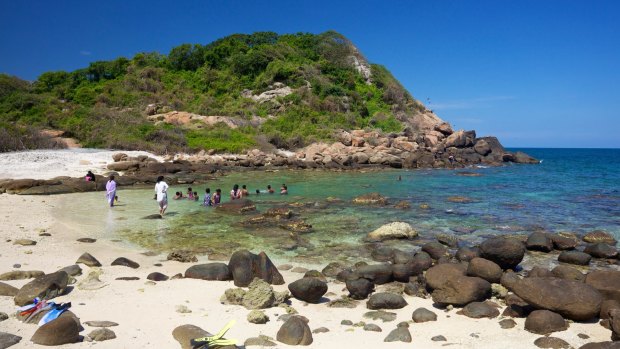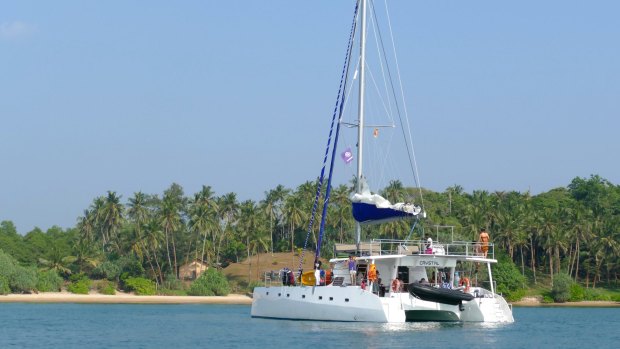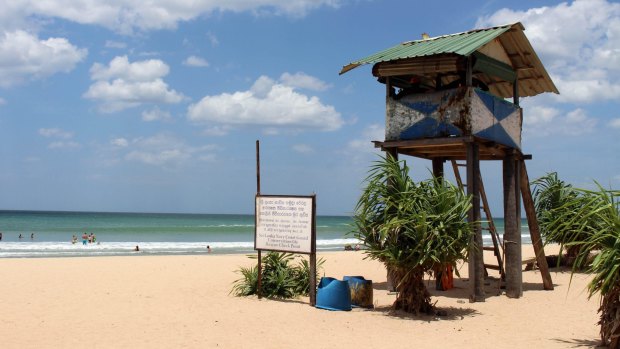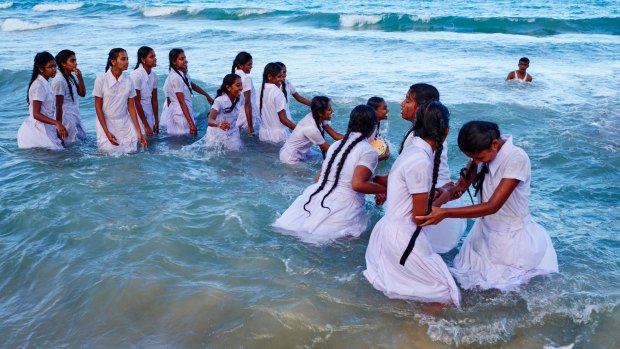This was published 5 years ago
Sailing Sri Lanka's east coast by catamaran: A beachy, coastline holiday in Sri Lanka

Coral beach on Pigeon Island National Park, Trincomalee, Sri Lanka.Credit: Alamy
It's the definition of slow travel, despite the fact we're travelling fast – for a yacht. Riding a 30-knot westerly along Sri Lanka's east coast, the sea flecked with white caps like a royal-blue lamington, our 16-metre catamaran is stoic and stately in the howling wind. I sit in the sun on deck rocking with the boat's motion, feeling as calm as a cloud. And it's only day one. So begins this week of ease, on water.
Sri Lanka had a record 2.3 million visitors last year, up from about 450,000 a decade ago when the civil war ended. Most of them stick to the south coast and the central highlands, lured by beachfront boutique hotels and surf spots, leopard safaris and tea plantations.
Now the east coast and the north, off-limits for 26 years until government forces defeated the Tamil Tigers in 2009, are putting out the welcome mat.

The Crystal is new, spacious and well-designed.
I'm on a new east coast sailing trip launched by G Adventures in July, which starts with a six-hour diagonal drive across the country from Colombo to the eastern port city of Trincomalee.
The sun is just setting when we pull up at a white-sand beach in "Trinco", as it's called. Even this late in the day, the water looks tropically turquoise and there are dozens of people swimming and socialising in the shallows.
"You wouldn't have seen this during the war," says Udi, our guide.

The lifeguard shack at Nilaveli beach in Trincomalee.Credit: Alamy
A zodiac whisks us out to our waiting vessel, lying at anchor in this quiet bay, and as soon as we step aboard I fall in love with the place we're to call home for a week. The Crystal is a beautiful boat: new, spacious and well-designed with teak decks, plenty of spots for lounging, an open-air dining area and four en suite cabins, two on each side.
G Adventures charters it for these trips from Sail Lanka, a sustainable social enterprise set up in 2014 by a Belgian philanthropist. All its yachts are designed and built locally and crewed by Sri Lankans, so it's a trip with a conscience.
My cabin is light and airy, all white with timber trim. There's a wall-to-wall bed, storage shelves, a "sunroof" (a clear hatch opening onto the deck, with a canvas cover for privacy) and an en suite with a hot shower, a flushing toilet and a porthole above the washbasin for Indian Ocean views while you brush your teeth.

Schoolgirls from Kandy play in the sea.Credit: Alamy
Although the maximum group size is eight, there are only five of us on this trip: two honeymooners from England, a young Italian couple and me.
The Crystal is purpose-built for couples, actually, with its double cabins (no twins), wide daybeds on the top deck and over-water nets between the bows, like hammocks built for two.
The next morning after breakfast, the trip really starts. Heading offshore towards a cluster of small fishing boats, we're suddenly surrounded by hundreds of bottlenose dolphins. They torpedo around us, ride our bow waves inches from our dangling feet and corkscrew through the air before splash-landing into the blue. (Some days you can see migrating blue whales too.)
An hour or so later, the spectacle ends and it's time to sail on.
The warm wind carries a sense of urgency (it's an unseasonably blowy week), but the Crystal glides serenely south, unhurried. I stare at the sea like a dog at the open window of a car, content to just look and be.
That afternoon we get our first chance to go ashore, at Sallitivu. Walking past brightly coloured outrigger canoes dotting the black sand beach, we see a couple of guesthouses – and an army base. The war might be over, but the military still has a presence on this coast, keeping the peace and supporting locals in times of need. Almost every day we see checkpoints or storm-grey patrol boats, which is oddly reassuring.
Our days slip into an easy routine: swim before breakfast, sail in the mornings, go ashore in the afternoons. Whenever we drop anchor, we swim again or take out a kayak or stand-up paddleboard. We read books and take naps and never look at a screen (there's no Wi-Fi). Most nights we're all in our cabins by 9pm.
We sail past long deserted golden beaches. The only other tourist boats we see all week are a couple of Sail Lanka catamarans.
But it's not all untouched. On the afternoon of day three, we stop at Passikudah. Low-rise resorts sprawl along the beachfront, jet skis buzz around us and music thumps across the water from a beachside bar. My shipmates and I exchange glances. What are we doing here?
It turns out our chef, Shantha, needs supplies; we go ashore with him for a stroll, but feel glad to return to the sanctuary of the Crystal.
The food is an unexpected highlight of the trip. Shantha, recently retired from 22 years in the Sri Lankan Navy, wows us every day with his culinary creations. Everything is fresh or freshly made; the scent of spices wafting from the galley announces every meal.
Breakfast is a feast of tropical fruit and cooked options such as coconut rice, omelettes or samosas, with Sri Lankan tea and good coffee. Lunch and dinner are three-course affairs featuring baked fish, salads, assorted curries and Sri Lankan specialties such as thosa (flatbread) and string hoppers (rice flour patties) and, for dessert, creamy buffalo curd topped with treacle.
Our shore excursions also give us a taste of where we are, a glimpse of a lesser known Sri Lanka. At Kalkuda, we see the whole village hauling in a vast fishing net, and join in to help. At Lanka Patuna, we get panoramic views down the coast from a hilltop Buddhist temple rebuilt after the war and dedicated to the "sacred tooth relic" (a symbol of Sri Lankan Buddhism based around Gautama Buddha's left canine).
On day five, we stop at Trinco again to visit the city's main attraction: Fort Frederick. First built by the Portuguese in 1624, it was rebuilt by successive waves of Dutch, French and British colonials on the cliff-hugging site of a medieval Hindu temple and pilgrimage site that has the last word: Koneswaram, known as "the Rome of the Orient", and its enormous blue Shiva statue now lord over the bay.
We see Lord Shiva from the sea the next day too on our way north to Pigeon Island National Park, one of only two marine parks in Sri Lanka.
The island is packed with day-trippers when we arrive: people frog-marching in their fins along the beach, women in bikinis and burqas, languages and accents from all over the globe. Putting on our masks and snorkels and swimming over the fringing coral reef, we find it's a rainbow-nation out there too, a clear-water world of colourful corals, turtles, reef sharks and more than 300 species of tropical fish.
Our last adventure is at Nilaveli Beach. The waves are too big for our zodiac, so it drops us in deep water behind the breakers and we swim to shore, our towels and sunglasses in dry bags, then spend a happy hour bodysurfing and beachcombing before swimming back out again.
There's a lot to love about sailing in Sri Lanka: barefoot days and balmy nights, swimming and sunshine and the chance to experience this incredible country in a new way. On the east coast you get a new destination too, and serenity and a sense of adventure in equal measure. And plenty of slow-travel time.
Louise Southerden travelled as a guest of G Adventures.
TRIP NOTES
MORE
FLY
SriLankan Airlines flies direct to Colombo from Melbourne and via Singapore from Sydney, Brisbane, Adelaide and Perth. See srilankan.com
Tourist visas for Sri Lanka cost $US35 online, $US40 on arrival. See eta.gov.lk/slvisa/
SAIL
G Adventures runs seven-day east coast sailing trips July-September from $1999 per person including accommodation aboard the Crystal, meals, activities and return transfers to Trincomalee. There are also seven-day south coast sailing trips November-April and north coast sailing trips starting in November this year, both from $2059. See gadventures.com
FIVE OTHER PLACES TO SEE IN NORTH-EAST SRI LANKA
JAFFNA
The train line connecting Colombo and Jaffna reopened in 2013 and is a great introduction to this very Tamil northern city and its islands offshore, some of which have wild horses and African baobabs.
TRINCOMALEE
One of the best places to stay in Trinco is the retro-styled Trinco Blu, a 1960s beach resort refurbished in 2010 by the Sri Lankan-owned Cinnamon hotel group. See cinnamonhotels.com
BATTICALOA
Two hours south of Trinco, "Batti" was a dangerous place during the war. Now you can stay in a cabin beside its peaceful lagoon and do night-time boat tours to hear its singing fish. See riviera-online.com
THE DUMBARA (KNUCKLES) RANGE
These forested mountains north-east of Kandy are ideal for hiking. The wildlife includes purple-faced leaf monkeys and giant squirrels. See bestoflanka.com
CHUNDIKKULAM
This bird sanctuary became a national park in 2015 and gets an incredible variety of migratory birds including flamingoes. There's also treehouse accommodation. See thalsevanaresort.com
Sign up for the Traveller Deals newsletter
Get exclusive travel deals delivered straight to your inbox. Sign up now.